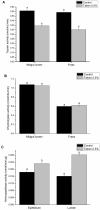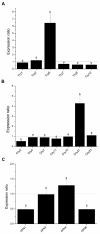Effects of a Reserve Protein on Spodoptera frugiperda Development: A Biochemical and Molecular Approach to the Entomotoxic Mechanism
- PMID: 32397098
- PMCID: PMC7249069
- DOI: 10.3390/molecules25092195
Effects of a Reserve Protein on Spodoptera frugiperda Development: A Biochemical and Molecular Approach to the Entomotoxic Mechanism
Abstract
Talisin is a storage protein from Talisia esculenta seeds that presents lectin-like and peptidase inhibitor properties. These characteristics suggest that talisin plays a role in the plant defense process, making it a multifunctional protein. This work aimed to investigate the effects of chronic intake of talisin on fifth instar larvae of Spodoptera frugiperda, considered the main insect pest of maize and the cause of substantial economic losses in several other crops. The chronic intake of talisin presented antinutritional effects on the larvae, reducing their weight and prolonging the total development time of the insects. In addition, talisin-fed larvae also showed a significant reduction in the activity of trypsin-like enzymes. Midgut histology analysis of talisin-fed larvae showed alterations in the intestinal epithelium and rupture of the peritrophic membrane, possibly causing an increase of aminopeptidase activity in the midgut lumen. Talisin also proved to be resistant to degradation by the digestive enzymes of S. frugiperda. The transcription profile of trypsin, chymotrypsin and aminopeptidase genes was also analyzed through qPCR technique. Talisin intake resulted in differential expression of at least two genes from each of these classes of enzymes. Molecular docking studies indicated a higher affinity of talisin for the less expressed enzymes.
Keywords: bioinsecticides; enzyme activity; insect gut; lectin properties; multifunctional protein.
Conflict of interest statement
The authors declare no conflict of interest.
Figures








Similar articles
-
Bioinsecticidal activity of Talisia esculenta reserve protein on growth and serine digestive enzymes during larval development of Anticarsia gemmatalis.Comp Biochem Physiol C Toxicol Pharmacol. 2011 Jan;153(1):24-33. doi: 10.1016/j.cbpc.2010.08.001. Epub 2010 Aug 6. Comp Biochem Physiol C Toxicol Pharmacol. 2011. PMID: 20692365
-
SfREPAT38, a pathogen response gene (REPAT), is involved in immune response of Spodoptera frugiperda larvae through mediating Toll signalling pathway.Insect Mol Biol. 2024 Aug;33(4):417-426. doi: 10.1111/imb.12909. Epub 2024 Mar 28. Insect Mol Biol. 2024. PMID: 38549231
-
Role of digestive protease enzymes and related genes in host plant adaptation of a polyphagous pest, Spodoptera frugiperda.Insect Sci. 2021 Jun;28(3):611-626. doi: 10.1111/1744-7917.12906. Epub 2021 Feb 24. Insect Sci. 2021. PMID: 33629522
-
Insensitive trypsins are differentially transcribed during Spodoptera frugiperda adaptation against plant protease inhibitors.Comp Biochem Physiol B Biochem Mol Biol. 2013 May;165(1):19-25. doi: 10.1016/j.cbpb.2013.02.008. Epub 2013 Mar 4. Comp Biochem Physiol B Biochem Mol Biol. 2013. PMID: 23466392
-
Comparative analysis of the detoxification gene inventory of four major Spodoptera pest species in response to xenobiotics.Insect Biochem Mol Biol. 2021 Nov;138:103646. doi: 10.1016/j.ibmb.2021.103646. Epub 2021 Aug 29. Insect Biochem Mol Biol. 2021. PMID: 34469782 Review.
References
-
- United Nations Population Division The 2015 Revision of the UN’s World Population Projections. Popul. Dev. Rev. 2015;41:557–561. doi: 10.1111/j.1728-4457.2015.00082.x. - DOI
-
- Carzoli A.K., Aboobucker S.I., Sandall L.L., Lübberstedt T.T., Suza W.P. Risks and opportunities of GM crops: Bt maize example. Glob. Food Secur. 2018;19:84–91. doi: 10.1016/j.gfs.2018.10.004. - DOI
-
- De Santis B., Stockhofe N., Wal J.-M., Weesendorp E., Lallès J.-P., van Dijk J., Kok E., De Giacomo M., Einspanier R., Onori R., et al. Case studies on genetically modified organisms (GMOs): Potential risk scenarios and associated health indicators. Food. Chem. Toxicol. 2018;117:36–65. doi: 10.1016/j.fct.2017.08.033. - DOI - PubMed
-
- Dunse K.M., Stevens J.A., Lay F.T., Gaspar Y.M., Heath R.L., Anderson M.A. Coexpression of potato type I and II proteinase inhibitors gives cotton plants protection against insect damage in the field. Proc. Natl. Acad. Sci. USA. 2010;107:15011–15015. doi: 10.1073/pnas.1009241107. - DOI - PMC - PubMed
-
- Huang F., Qureshi J.A., Meagher R.L., Jr., Reisig D.D., Head G.P., Andow D.A., Ni X., Kerns D., Buntin G.D., Niu Y., et al. Cry1F resistance in fall armyworm Spodoptera frugiperda: Single gene versus pyramided Bt maize. PLoS ONE. 2014;9:e112958. doi: 10.1371/journal.pone.0112958. - DOI - PMC - PubMed
MeSH terms
Substances
LinkOut - more resources
Full Text Sources

